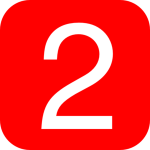Cé Hé Uimhir a Sé? — Practicing Some Numbers in Irish Posted by róislín on Jan 28, 2015 in Irish Language
(le Róislín)
‘Cé hé Uimhir a Sé?’ That might seem like an odd question at first, but, remember the number that was in the graphic for the last blog (nasc thíos)? There was a reason for picking that number to illustrate the theme from The Prisoner. In this blog, we’ll look a little closer at uimhreacha and we’ll also start a mini-series showing some fun ways to look at numbers in Irish.
Of course, the beginning is a very good place to start, so first let’s review the “bunuimhreacha” and the “maoluimhreacha.” What’s the difference? The bunuimhreacha are used to actually count things (except, sometimes, people, which has a separate system). Uses for the maoluimhreacha, in contrast, include such situations as:
* saying phone numbers, lottery ticket numbers, confirmation numbers, identification numbers, seat numbers, bus and train numbers,
* numbers in arithmetic problems, addresses, countdowns, mathematically mysterious TV shows (like ABC’s Lost’s 4, 8, 15, 16, 23, 42), and,
* telling time
In a few circumstances, Irish uses the maoluimhir (a haon, a dó, srl.) where English uses the ordinal (first, second, etc.) number: an Rí Séamas a Sé, King James the Sixth (although “the sixth,” as such, is “an séú”)
Ascaill a Cúig, Fifth Avenue, or it could mean “Armpit Number Five,” but that’s another blog topic altogether. In general, I haven’t seen too many street names like “Ascaill a Cúig” or “Sráid a Ceathair Déag” because there don’t seem to be many numbered streets in Irish cities. In fact, it seems to be mostly relatively new cities or developments that use numbers in street names. They’re often found in American cities and town that are laid out on a grid system, like New York, Philadelphia, and Washington, and in some other areas around the world.
If you’re quite new to Irish, you might also want to check out Transparent’s YouTube video on numbers for pronunciation: https://www.youtube.com/watch?v=a-t5NzoxdfE. And while you’re at it, you could subscribe to Transparent’s YouTube Channel (https://www.youtube.com/user/TransparentIrish).
Now let’s do a quick review of numbers (maoluimhreacha, bunuimhreacha) and then see if we can have fun matching the numbers to the context in questions 1-6 below. Remember, the “maoluimhreacha” (independent numbers) are preceded by the numerical particle “a.” It has no meaning as such, it just indicates that a maoluimhir is coming up. It looks like the particle “a” used for direct address (“a Mháire,” “a Sheáin,” srl.) and the “a” used to show possession (a leabhar, a mhadra, a cat), but this “a” is a completely different part of speech.
maoluimhreacha: a haon, a dó, a trí, a ceathair, a cúig, a sé, a seacht, a hocht, a naoi, a deich
bunuimhreacha (counting cats in these examples): cat amháin, dhá chat, trí chat, ceithre chat, cúig chat, sé chat, seacht gcat, ocht gcat, naoi gcat, deich gcat
Agus anois, cleachtadh le meaitseáil (ó 1 go 6) agus le banc focal:
banc focal: a haon, a dó, a trí, a ceathair, a cúig, a sé (you may need to make capitalization changes)
Líon isteach na bearnaí anseo (Tá na freagraí thíos). Leideanna: aonair, of one person; gan, without (here: “not to”); radharc, scene; úsáidtear, is used, are used; chun, in order to; ar do shon, for your sake; digit, digit (ach abair “DIGG-yitch” le “g crua” i nGaeilge); na huimhreach, of the number; bheadh, would be; dá mbeadh, if there would be; leagan, version; ann, there, in it (here: “in existence”); suite, set (as in: set in a galaxy far away, set on a distant planet, etc.); réaltach, stellar, star; cumtha, fictitious, made up.
- caint aonair Hamlet (“a bheith nó gan a bheith”) i nGníomh _________, Radharc a hAon de Hamlet
- an uimhir a úsáidtear i “dtéacsais Béarla” chun rudaí mar “duit” nó “ar do shon” a rá: an digit anseo: “___u” agus ainm na huimhreach i nGaeilge anseo: ________.
- Séarlas ______________
- ___________ dhéag (.i. 12)
- An uimhir a bhí ar charachtar Patrick McGoohan sa chlár teilifíse An Príosúnach (ainm an chláir dá mbeadh leagan Gaeilge ann): ____________
- Dá mbeadh Gaeilge air, bheadh “Bablóin ___________” mar theideal ar an gclár teilifíse ficsean eolaíochta atá suite ar stáisiún spáis sa chóras réaltach Epsilon Eridani, idir an bpláinéad cumtha Epsilon III agus a ghealach.
Up next? More practice with numbers. Idir an dá linn, bain sult as a bheith ag comhaireamh (ag áireamh). SGF — Róislín
Freagraí
1. a trí
2. “4u” (i.e. “for you”), ceathair
3. a hAon (actually this could also be “a Dó,” except we need that answer for no. 4)
4. a dó
5. a sé
6. a cúig
Nasc: ‘I am not an ‘uimhir’ ‘ and Other Indefinite Predicate Nominatives — Let’s Say Them in Irish, Posted on 23. Jan, 2015 by róislín in Irish Language (https://blogs.transparent.com/irish/i-am-not-an-uimhir-and-other-indefinite-predicate-nominatives-lets-say-them-in-irish/)

Build vocabulary, practice pronunciation, and more with Transparent Language Online. Available anytime, anywhere, on any device.









Leave a comment: